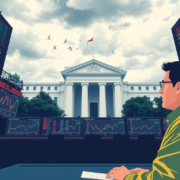U.S. Jobs Report Disappoints: Labor Market Cooling Signals Fed’s Cautious Path Ahead
U.S. Jobs Report Misses Forecast: Weak Nonfarm Payrolls Signal Labor Market Cooling
By James Hyerczyk | Updated: September 5, 2025, 13:18 GMT
The latest U.S. employment data shows signs of a cooling labor market. In August, nonfarm payrolls grew by 22,000. This number falls far short of the 75,000 jobs that market experts predicted. The report shows slower job gains and casts doubt on the strength of the U.S. economy and on the Federal Reserve’s money policy path.
Labor Market Momentum Slows Sharply
On Friday, the August data came out. The numbers show job creation was much weaker than expected. The unemployment rate edged up to 4.3% from 4.2%. This small rise shows weaker worker activity.
Even with a small payroll gain, average hourly pay grew 0.3% to $36.53. Yearly, wages increased by 3.7%. The labor force participation rate held at 62.3%. This rate stays lower than last year and shows little change in worker engagement.
Sector Performance Reflects Uneven Job Growth
Most new jobs came in health care and social assistance. Health care added 31,000 jobs while social assistance added 16,000 jobs. In health care, this total is lower than last year’s monthly average of 42,000 jobs. Most gains in social assistance came from family services positions.
At the same time, several sectors lost jobs. These losses balanced the small gains in some areas:
- Federal government jobs fell by 15,000. This drop has been steady since January.
- Jobs in mining, quarrying, and oil and gas extraction decreased by 6,000.
- Manufacturing lost 12,000 jobs. Within this field, transportation equipment manufacturing lost 15,000 jobs because of strikes.
- Wholesale trade dropped by 12,000 jobs over three months, with a total decline of 32,000 jobs.
- Construction lost 7,000 jobs.
- Professional and business services reduced by 17,000 jobs.
- Financial activities cut 3,000 jobs.
On a brighter note, retail trade added 10,500 jobs. Leisure and hospitality gained 28,000 jobs, and transportation and warehousing added 3,600 jobs.
Workforce Indicators Suggest Tepid Labor Market Confidence
Long-term unemployment rose to 1.93 million people. This group now makes up more than one-quarter of all unemployed. New job seekers dropped by 199,000 after gains in the previous month. This fall may point to less confidence among those looking for work.
The employment-population ratio stayed at 59.6%. This flat figure shows that the share of Americans with jobs remains unchanged.
Market and Policy Implications
The weak jobs data and the rise in unemployment send a clear signal. The U.S. labor market is losing steam. This trend may affect the whole economy. It hints at lower consumer spending, which might slow economic growth.
For the Federal Reserve, the weak data may support a cautious approach in policy decisions. Slower job growth cools the rise in wages and prices. The central bank might pause any further hikes in interest rates to keep the recovery on track without deepening a slowdown.
Financial markets reacted by buying assets sensitive to rate changes such as U.S. Treasuries and technology stocks. At the same time, the U.S. dollar showed a weak trend as traders expect a gentler response from the Fed soon.
Summary
- Nonfarm payrolls grew by 22,000 in August, a number much smaller than the forecast of 75,000.
- The unemployment rate increased from 4.2% to 4.3%.
- Average hourly pay increased by 0.3% to $36.53 while yearly wage growth was 3.7%.
- Labor force participation held at 62.3%.
- Job gains were seen in health care and social assistance while losses hit the federal government, manufacturing, and mining sectors.
- Long-term unemployment and a drop in new job seekers point to less trust among those hunting for work.
- Market views favor a gentle Fed approach, a stance that pushed rate-sensitive investments up and put pressure on the U.S. dollar.
This report shows that the U.S. labor market is weak. It highlights the hard path ahead for policy makers and investors in these changing times.
About the Author:
James Hyerczyk is a U.S.-based technical analyst and educator with more than 40 years of market analysis and trading experience. He studies chart patterns and price moves and has written two books on technical analysis.
The information here is for learning and informational purposes only and does not count as financial advice. Please do your own research and consult a financial advisor before making any decisions.
Full money-growing playbook here:
youtube.com/@the_money_grower









